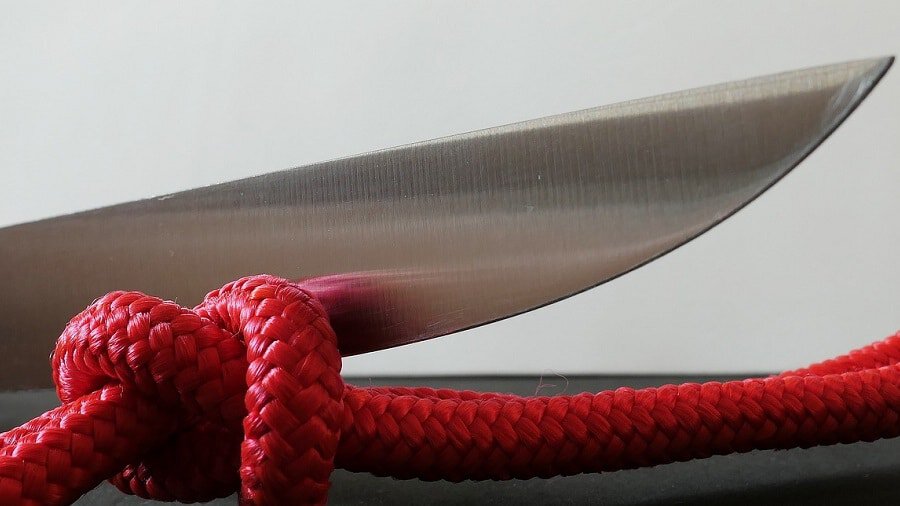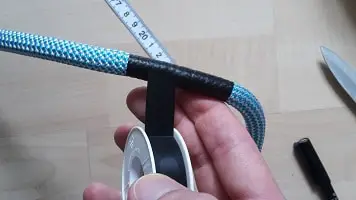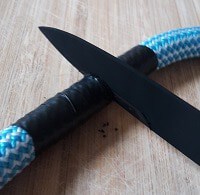Disclosure: Links marked with * are Affiliate Links. As an Amazon Associate, I earn from qualifying purchases if you decide to make a purchase through these links – at no cost for you!
 Climbing ropes are stressed the most at their ends. There most of the friction is caused by carabiners and usually, this is where the first damage occurs. Especially when lead climbing, where the climbing rope is always hooked into the next carabiner, damage occurs extra quickly, as the rope has to pass the carabiner every time you fall. Therefore it makes sense to shorten the rope at the ends instead of throwing it away completely. In most cases, the middle of a climbing rope still looks brand new while the two ends have already been shortened a few times.
Climbing ropes are stressed the most at their ends. There most of the friction is caused by carabiners and usually, this is where the first damage occurs. Especially when lead climbing, where the climbing rope is always hooked into the next carabiner, damage occurs extra quickly, as the rope has to pass the carabiner every time you fall. Therefore it makes sense to shorten the rope at the ends instead of throwing it away completely. In most cases, the middle of a climbing rope still looks brand new while the two ends have already been shortened a few times.
But what is the best way to cut a climbing rope? When cutting your climbing rope, make sure that the sheath does not come off the inner part of the rope and that the rope does not fray. Make sure you do this by taping the area where you want to cut. You should also melt the cut end with a lighter. This is very important so that the individual strands of the rope are connected to each other.
Read some helpful tips further down and learn how to increase the lifespan of your climbing rope and when it is definitely broken.
Step 1: Climbing Rope Marking and Taping
 First, you have to locate the damaged spot. From this point, mark the spot where you want to cut the climbing rope at least 30 cm away.
First, you have to locate the damaged spot. From this point, mark the spot where you want to cut the climbing rope at least 30 cm away.
If there is no obvious damage, but you know that the climbing rope has been overstressed by a heavy fall, for example, you should cut off 3 to 5 m from both ends.

Mark the spot where you want to cut the climbing rope and tape the rope about two fingers wide around the marking to the left and right as tightly as possible.
I usually use fingertape or climbing tape* for this, but normal insulating tape or similar is also OK. The tape only ensures that the coat and the inside of the climbing rope do not separate and fray.
Step 2: Tighten the Climbing Rope
If you pull the climbing rope apart tightly, it is much easier to cut. Of course, this works best when two people are involved. Otherwise, you can tie one end to something or stand on it, pull with one hand and cut with the other.
The tighter the better!
Step 3: Cutting the Climbing Rope
 Once you have taped the climbing rope and are holding it tightly, you can now cut it with a sharp knife. Make sure here that the knife is as sharp as possible.
Once you have taped the climbing rope and are holding it tightly, you can now cut it with a sharp knife. Make sure here that the knife is as sharp as possible.
If you have a hot air gun or kitchen burner and the knife is not too valuable, you can ideally heat the knife as much as you can before cutting. This makes it even easier to cut through the rope and the individual threads and strands are immediately fused together.
Step 4: Melt the Ends of the Climbing Rope
Whether you cut the climbing rope with a cold or a hot knife, you now have to melt the two ends together completely with a lighter.
By melting them together, the individual threads inside the climbing rope are connected to each other and to the sheath and fraying is prevented.
For an optimal result, you should squeeze the hot, melted end together with wet fingers so that everything is completely connected.
A Few Helpful Tips
 Because you have to shorten your climbing rope a few times to remove damaged ends, you should always choose a longer climbing rope than you actually need.
Because you have to shorten your climbing rope a few times to remove damaged ends, you should always choose a longer climbing rope than you actually need.
This way you have a longer rope and do not have to dispose of it immediately because it is too short. Especially when lead climbing, the rope is especially stressed at the ends. If you are lead climbing more than toprope climbing, a longer climbing rope is especially recommended.
In addition, many climbing ropes have a marking in the middle, so that you can estimate how high you already are when climbing. If you only cut one end of the climbing rope, you must update the marking.
And if you write on the tape how long the rope is, you’ll always know if it’s enough for your favorite track or not. There is nothing as frustrating as if you have to turn back just before the end of your route because the climbing rope is too short.
Increase the Life Span of your Climbing Rope
 If you pay attention to a few things when climbing, you can considerably prolong the life of your climbing rope.
If you pay attention to a few things when climbing, you can considerably prolong the life of your climbing rope.
The most common mistake I see is that you don’t give the climbing rope a break after a fall. If you slip off and fall into the rope while climbing (which is totally normal), do not stay in the rope, but hold on to the wall so that the climbing rope hangs next to you again without pulling.
When lead climbing, you can simply hook your harness directly to an anchor. Then you can relax for a moment and give the climbing rope a chance to recover from the fall.
Quickdraws and carabiners don’t last forever either. Make sure that they do not have sharp edges that could fray or otherwise damage your climbing rope. Things can get really dangerous here. In a fall, high forces act and a sharp edge can give a strained rope the rest and cause it to break.
Most climbing accidents in which the climbing rope snapped are due to poorly cared for and maintained equipment. So always take care of your safety equipment!
Guiding the climbing rope correctly over the rocks is also important. This has usually already been taken into account for pre-established climbing routes. But if you set your own anchors while climbing, you must make sure that your climbing rope is not guided over sharp rock edges. These can damage the climbing rope just as much as a sharp metal edge.
When do I have to Dispose of my Climbing Rope?
If you are unsure whether your climbing rope has been through too much and should be disposed of, the most important KO criteria are listed below.
You should always dump your climbing rope when one of the following things has happened:
- If the climbing rope has come into contact with chemicals. Acids of all kinds are particularly bad.
- If the sheath is very frayed and worn-out.
- If the sheath is so frayed that you can see the core.
- When the sheath slips over the core.
- If the climbing rope is so dirty that it can no longer be washed clean.
- If the climbing rope is damaged by sun or heat.
- If the climbing rope is rigid or has hard spots.
- If the climbing rope has already been through several hard falls. You have to imagine the rope as a spring. The more often you stretch it, the less elastic it becomes. At some time or other, the point is reached when the elasticity is at its end and a fall can end fatally. Before this point, it is necessary to replace it.
Need a new rope? Click here to search on Amazon*.
Summary
Cutting a climbing rope is not that difficult if you know what you are doing. Tape the spot where you want to cut as tightly as possible, pull the climbing rope and cut it with a very sharp knife. Then melt the ends with a lighter and press them together – done!
If you take care not to put unnecessary mechanical stress on the rope when climbing, you will enjoy your climbing rope for a very long time. And if you buy it a few meters longer than you need, shortening the ends is not tragic either.
Attention: You have to take care of your safety when climbing! The information on climbtheearth.com only helps you to learn. Before you climb, you should make sure that you have been properly instructed by an expert and that you follow all safety precautions.
Disclosure: This website is the property of Martin Lütkemeyer and is operated by Martin Lütkemeyer. Martin Lütkemeyer is a member of the Amazon Services LLC Affiliate Program, an affiliate advertising program designed to enable Web sites to earn advertising revenue through advertising and linking to Amazon.com. Links marked with * are affiliate links.